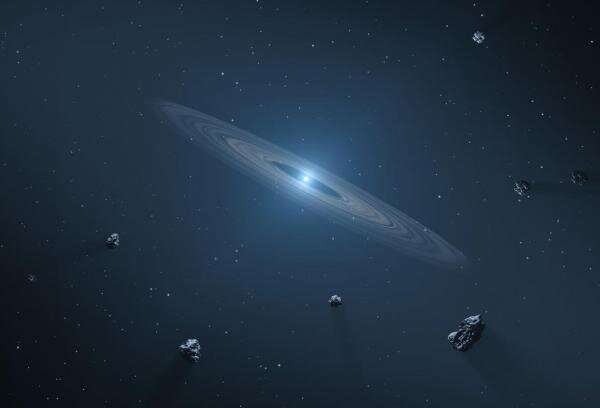White dwarf stars' debris disk formation delayed

White dwarfs, the glowing cores of dead stars, often host disks of dusty debris. However, these debris disks only appear 10 to 20 millions of years following the star's violent Red Giant phase. A new paper by Planetary Science Institute Research Scientist Jordan Steckloff unravels the reason for this delay.
"When a star similar in mass to the sun runs out of nuclear fuel, it first expands outward into a Red Giant. At the end of our own sun's life, it will expand into a Red Giant that envelopes and destroys the innermost planets: Mercury, Venus, and probably the Earth. During this phase, Red Giant stars also loses a large fraction of their mass, before ultimately collapsing into a white dwarf—an Earth-sized ball of carbon and oxygen with half the mass of the sun. This destabilizes the orbits of any remaining planets, which can in turn scatter asteroids, flinging some of them toward the host white dwarf." said Steckloff, lead author of "How Sublimation Delays the Onset of Dusty Debris Disk Formation Around White Dwarf Stars," published in the Astrophysical Journal Letters. PSI Senior Scientist Elisabeth R. Adams is a co-author.
Debris disks form when planetary bodies such as these asteroids get too close to their host star—the white dwarf—whose tidal forces can pulverize them into dust. Therefore, young, hot white dwarfs, which host destabilized planetary systems, are expected to rapidly form dusty debris disks. However, observations show that dusty debris disks form only after a long delay.
"We found that this delay is a result of these young white dwarfs being extremely hot. So hot that any dust that forms from a tidally disrupted asteroid rapidly vaporizes and dissipates. We found that this dust only stops vaporizing after the white dwarf has had time to sufficiently cooled down, to a surface temperature of approximately 27,000 degrees kelvin (48,000 degrees Fahrenheit). This temperature agrees with observations of these white dwarf systems; all dusty debris disks are found around white dwarfs cooler than this critical temperature," Steckloff said.
"Our solar system will follow this fate in a few billion years, when the sun runs out of fuel, expands into a Red Giant and then ultimately collapse into a white dwarf," Steckloff said. Most of the inner planets will be destroyed, and Jupiter will migrate outward, destabilizing the orbits of asteroids in our asteroid belt. Some of these asteroids may end up passing very close to the sun, where stellar tides may break them up to form dusty debris disks. In other words, we may be looking at a glimpse of our own home system in the distant future."
More information: Jordan K. Steckloff et al, How Sublimation Delays the Onset of Dusty Debris Disk Formation around White Dwarf Stars, The Astrophysical Journal Letters (2021). DOI: 10.3847/2041-8213/abfd39
Journal information: Astrophysical Journal Letters
Provided by Planetary Science Institute





















